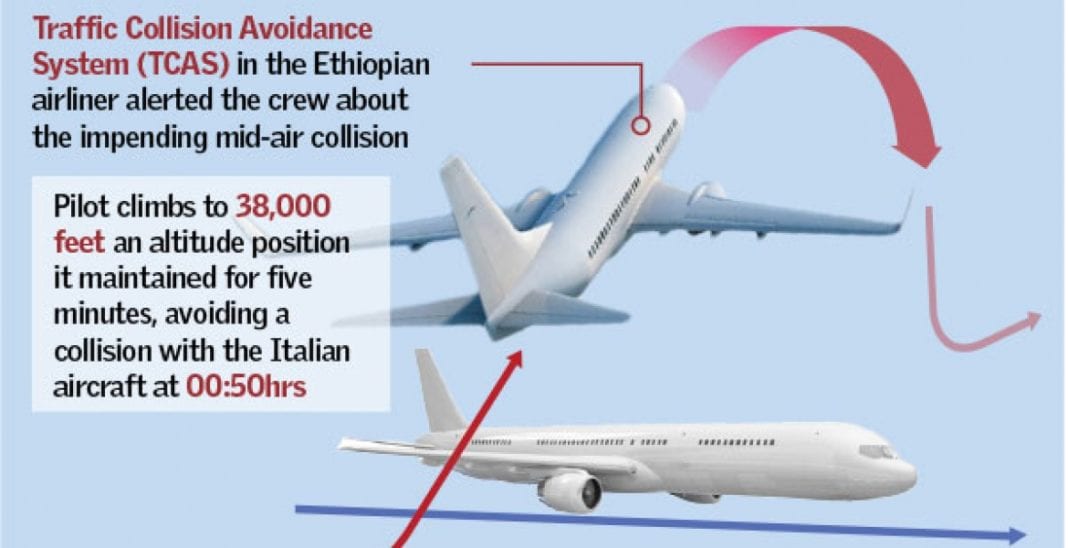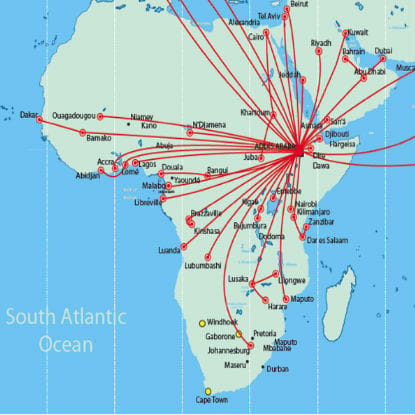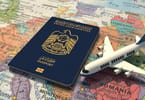Ethiopian Airlines and Neo were on a possible deadly collision course over Kenyan skies. Two weeks after a mid-air collision was narrowly avoided in the Kenyan airspace, aviation safety concerns in African skies remain a key debate among the continent’s aviation departments and governments.
Ethiopian passenger jet and the Italian Neos SpA leisure plane were reported to have avoided mid-air collision after the Ethiopian Airlines pilot climbed 1000 feet to skip a possible collision between the two aircraft, all flying the same converging path.
Media reports said this ending that the near-collision involving an Ethiopian jet and an Italian Neos SpA Leisure airline was prevented when the Ethiopian Airlines pilot made a sudden climb to avoid the converging Italian plane in southern Kenya skies.
Less than a minute before possible mid-air collision, the Ethiopian Boeing 737-800 climbed to 38,000 feet and thus avoided a potential collision. One minute later the aircraft descended again to its cruising altitude. Both flights continued to their destinations without further incident, Kenyan media reports said.
Kenyan traffic control sources blamed Ethiopian air-traffic controllers who were on strike to have been a source of averted aircraft mid-air collision, the horrific aviation accident that could hit the African skies.
On August 29, the Ethiopian Airlines flight number ET 858, Boeing 737-800 with registration number ET- ASJ left Johannesburg in South Africa for Addis Ababa at 2100 hours while the Italian leisure airline Neos Boeing 767-306R flight number NOS252 left the Italian city of Verona heading to Zanzibar in Tanzania at 1800 hours.
Just after midnight, the two planes were flying right into each other at the same at a calibrated altitude of 37,000 feet, with the Italian aircraft having entered from the Ethiopian airspace, while the Ethiopian Airlines from the Tanzania airspace when they narrowly escaped a possible collision while flying over Naivasha town in southern Kenya, media reports said.
But Kenya Civil Aviation Authority (KCAA) has denied claims over the averted mid-air collision between the two passenger planes, saying air traffic controllers in Kenyan capital Nairobi did their work as expected to prevent possible collision.
KCCA director-general Gilbert Kibe told the media that disputed collision in Kenyan skies was misleading.

Contacted for comments, Tanzania Civil Aviation experts expressed their shock over the report, saying the averted mid-air collision could have been avoided after Ethiopian Airlines plane received a warning from the in-flight Traffic Collision Avoidance System (TCAS) fitted in the aircraft.
They said that the Ethiopian plane entered Tanzanian skies from South Africa on its way to Addis Ababa, well guided by air traffic controllers in Dar es Salaam and Kilimanjaro airport stations before crossing to the southern Kenya air space.
Had it happened, that kind of mid-air collision could have been a horrific accident to happen in Africa to bring about a negative perception over the continent’s aviation safety.
The Italian leisure plane that was flying from Verona in Italy to the tourist island of Zanzibar which is part of Tanzania was in Kenyan skies when the near collision incidence was reported by the Kenyan media this ending week.
Africa is known to be poorly equipped with air control and aviation systems except few nations which managed to finance their aviation departments with modern radars. Kenya and Ethiopia operate modern radars which control the big flights operated by their national airlines which stand the leading in Africa.
Aviation sources in Tanzania said the reported near plane collision remains a mystery pending Ethiopian aviation authorities response.
WHAT TO TAKE AWAY FROM THIS ARTICLE:
- Just after midnight, the two planes were flying right into each other at the same at a calibrated altitude of 37,000 feet, with the Italian aircraft having entered from the Ethiopian airspace, while the Ethiopian Airlines from the Tanzania airspace when they narrowly escaped a possible collision while flying over Naivasha town in southern Kenya, media reports said.
- The Italian leisure plane that was flying from Verona in Italy to the tourist island of Zanzibar which is part of Tanzania was in Kenyan skies when the near collision incidence was reported by the Kenyan media this ending week.
- Ethiopian passenger jet and the Italian Neos SpA leisure plane were reported to have avoided mid-air collision after the Ethiopian Airlines pilot climbed 1000 feet to skip a possible collision between the two aircraft, all flying the same converging path.























